Hotel RevPAR Determinants: A Study of Milan Hotels
VerifiedAdded on 2020/07/22
|17
|5927
|78
AI Summary
This assignment requires an analysis of the determinants affecting the Revenue Per Available Room (RevPAR) of individual hotels in Milan, drawing evidence from relevant academic journal articles such as 'RevPAR determinants of individual hotels: evidences from Milan' by Testa and Sipe (2012). Additionally, consider the service-leadership competencies for hospitality management, environmental factors influencing hotel performance, and Porter's Generic Strategies.
Contribute Materials
Your contribution can guide someone’s learning journey. Share your
documents today.

Contemporary Hospitality
Management
Management
Secure Best Marks with AI Grader
Need help grading? Try our AI Grader for instant feedback on your assignments.
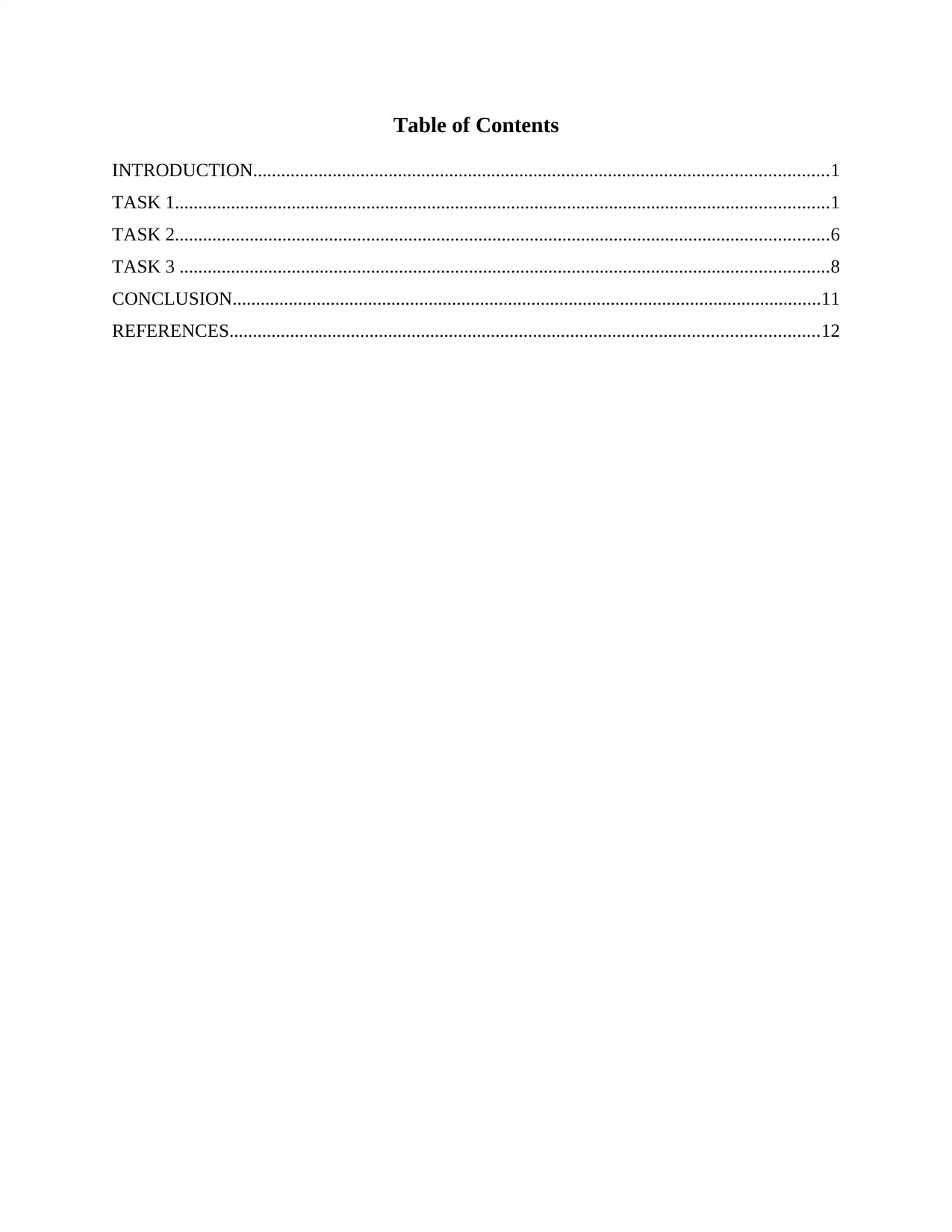
Table of Contents
INTRODUCTION...........................................................................................................................1
TASK 1............................................................................................................................................1
TASK 2............................................................................................................................................6
TASK 3 ...........................................................................................................................................8
CONCLUSION..............................................................................................................................11
REFERENCES..............................................................................................................................12
INTRODUCTION...........................................................................................................................1
TASK 1............................................................................................................................................1
TASK 2............................................................................................................................................6
TASK 3 ...........................................................................................................................................8
CONCLUSION..............................................................................................................................11
REFERENCES..............................................................................................................................12

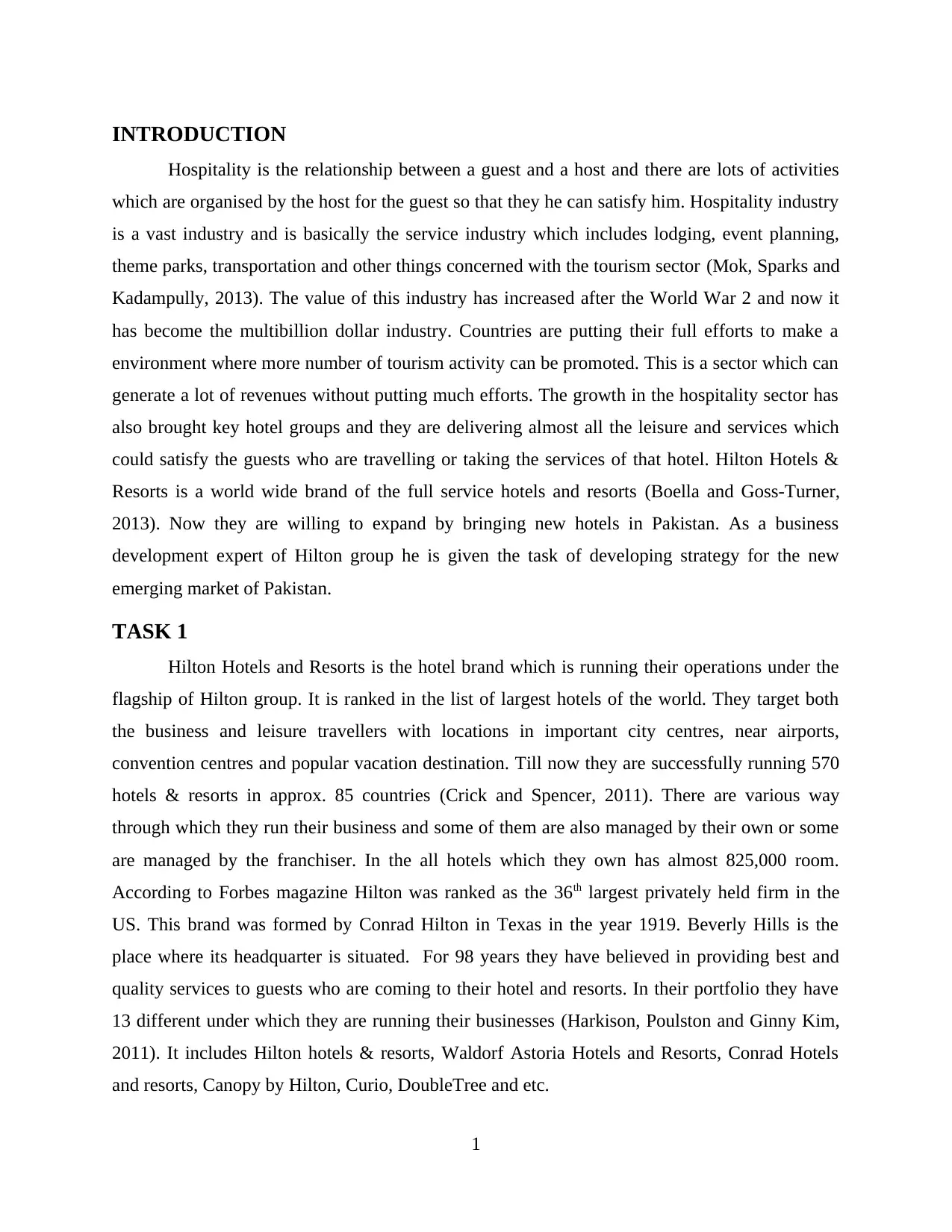
INTRODUCTION
Hospitality is the relationship between a guest and a host and there are lots of activities
which are organised by the host for the guest so that they he can satisfy him. Hospitality industry
is a vast industry and is basically the service industry which includes lodging, event planning,
theme parks, transportation and other things concerned with the tourism sector (Mok, Sparks and
Kadampully, 2013). The value of this industry has increased after the World War 2 and now it
has become the multibillion dollar industry. Countries are putting their full efforts to make a
environment where more number of tourism activity can be promoted. This is a sector which can
generate a lot of revenues without putting much efforts. The growth in the hospitality sector has
also brought key hotel groups and they are delivering almost all the leisure and services which
could satisfy the guests who are travelling or taking the services of that hotel. Hilton Hotels &
Resorts is a world wide brand of the full service hotels and resorts (Boella and Goss-Turner,
2013). Now they are willing to expand by bringing new hotels in Pakistan. As a business
development expert of Hilton group he is given the task of developing strategy for the new
emerging market of Pakistan.
TASK 1
Hilton Hotels and Resorts is the hotel brand which is running their operations under the
flagship of Hilton group. It is ranked in the list of largest hotels of the world. They target both
the business and leisure travellers with locations in important city centres, near airports,
convention centres and popular vacation destination. Till now they are successfully running 570
hotels & resorts in approx. 85 countries (Crick and Spencer, 2011). There are various way
through which they run their business and some of them are also managed by their own or some
are managed by the franchiser. In the all hotels which they own has almost 825,000 room.
According to Forbes magazine Hilton was ranked as the 36th largest privately held firm in the
US. This brand was formed by Conrad Hilton in Texas in the year 1919. Beverly Hills is the
place where its headquarter is situated. For 98 years they have believed in providing best and
quality services to guests who are coming to their hotel and resorts. In their portfolio they have
13 different under which they are running their businesses (Harkison, Poulston and Ginny Kim,
2011). It includes Hilton hotels & resorts, Waldorf Astoria Hotels and Resorts, Conrad Hotels
and resorts, Canopy by Hilton, Curio, DoubleTree and etc.
1
Hospitality is the relationship between a guest and a host and there are lots of activities
which are organised by the host for the guest so that they he can satisfy him. Hospitality industry
is a vast industry and is basically the service industry which includes lodging, event planning,
theme parks, transportation and other things concerned with the tourism sector (Mok, Sparks and
Kadampully, 2013). The value of this industry has increased after the World War 2 and now it
has become the multibillion dollar industry. Countries are putting their full efforts to make a
environment where more number of tourism activity can be promoted. This is a sector which can
generate a lot of revenues without putting much efforts. The growth in the hospitality sector has
also brought key hotel groups and they are delivering almost all the leisure and services which
could satisfy the guests who are travelling or taking the services of that hotel. Hilton Hotels &
Resorts is a world wide brand of the full service hotels and resorts (Boella and Goss-Turner,
2013). Now they are willing to expand by bringing new hotels in Pakistan. As a business
development expert of Hilton group he is given the task of developing strategy for the new
emerging market of Pakistan.
TASK 1
Hilton Hotels and Resorts is the hotel brand which is running their operations under the
flagship of Hilton group. It is ranked in the list of largest hotels of the world. They target both
the business and leisure travellers with locations in important city centres, near airports,
convention centres and popular vacation destination. Till now they are successfully running 570
hotels & resorts in approx. 85 countries (Crick and Spencer, 2011). There are various way
through which they run their business and some of them are also managed by their own or some
are managed by the franchiser. In the all hotels which they own has almost 825,000 room.
According to Forbes magazine Hilton was ranked as the 36th largest privately held firm in the
US. This brand was formed by Conrad Hilton in Texas in the year 1919. Beverly Hills is the
place where its headquarter is situated. For 98 years they have believed in providing best and
quality services to guests who are coming to their hotel and resorts. In their portfolio they have
13 different under which they are running their businesses (Harkison, Poulston and Ginny Kim,
2011). It includes Hilton hotels & resorts, Waldorf Astoria Hotels and Resorts, Conrad Hotels
and resorts, Canopy by Hilton, Curio, DoubleTree and etc.
1
Secure Best Marks with AI Grader
Need help grading? Try our AI Grader for instant feedback on your assignments.
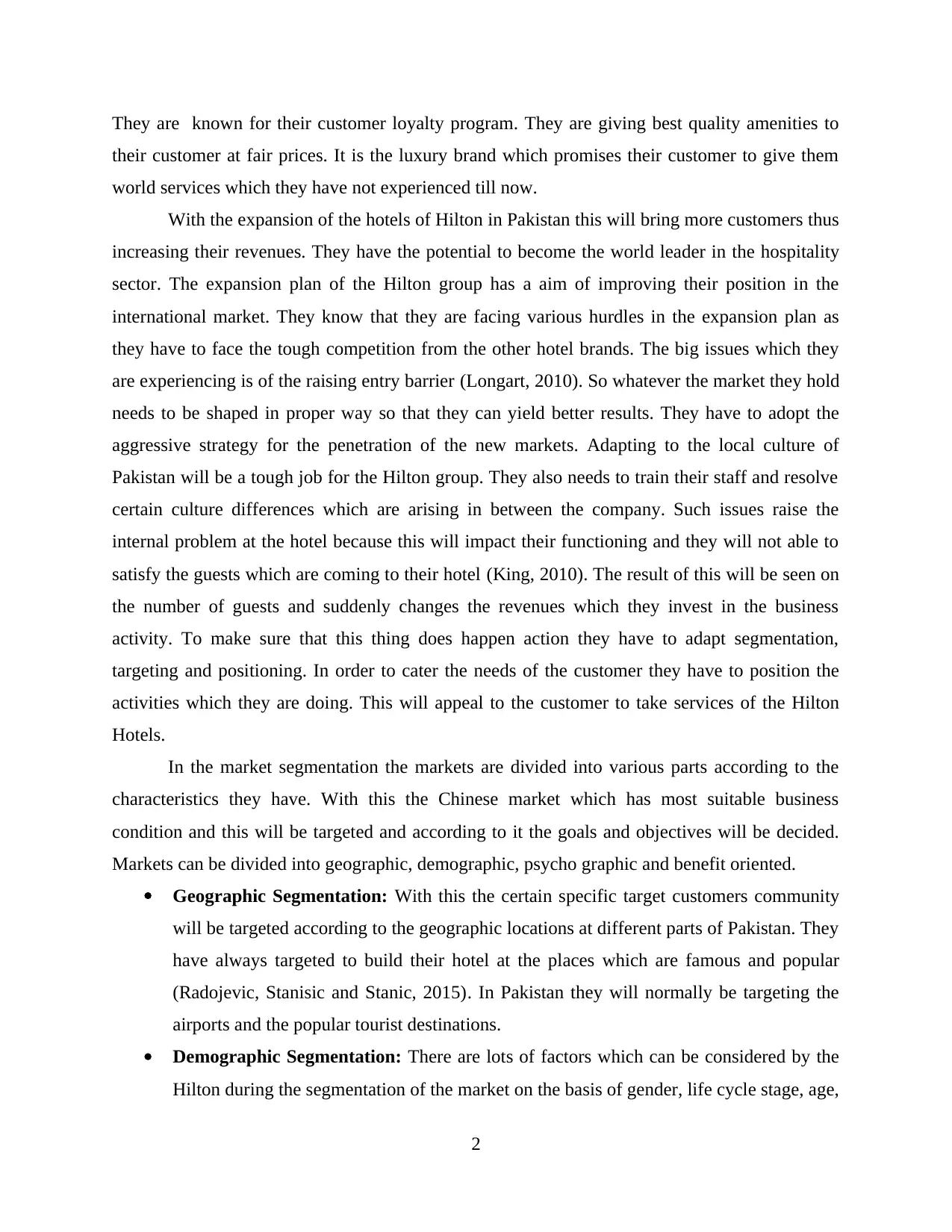
They are known for their customer loyalty program. They are giving best quality amenities to
their customer at fair prices. It is the luxury brand which promises their customer to give them
world services which they have not experienced till now.
With the expansion of the hotels of Hilton in Pakistan this will bring more customers thus
increasing their revenues. They have the potential to become the world leader in the hospitality
sector. The expansion plan of the Hilton group has a aim of improving their position in the
international market. They know that they are facing various hurdles in the expansion plan as
they have to face the tough competition from the other hotel brands. The big issues which they
are experiencing is of the raising entry barrier (Longart, 2010). So whatever the market they hold
needs to be shaped in proper way so that they can yield better results. They have to adopt the
aggressive strategy for the penetration of the new markets. Adapting to the local culture of
Pakistan will be a tough job for the Hilton group. They also needs to train their staff and resolve
certain culture differences which are arising in between the company. Such issues raise the
internal problem at the hotel because this will impact their functioning and they will not able to
satisfy the guests which are coming to their hotel (King, 2010). The result of this will be seen on
the number of guests and suddenly changes the revenues which they invest in the business
activity. To make sure that this thing does happen action they have to adapt segmentation,
targeting and positioning. In order to cater the needs of the customer they have to position the
activities which they are doing. This will appeal to the customer to take services of the Hilton
Hotels.
In the market segmentation the markets are divided into various parts according to the
characteristics they have. With this the Chinese market which has most suitable business
condition and this will be targeted and according to it the goals and objectives will be decided.
Markets can be divided into geographic, demographic, psycho graphic and benefit oriented.
Geographic Segmentation: With this the certain specific target customers community
will be targeted according to the geographic locations at different parts of Pakistan. They
have always targeted to build their hotel at the places which are famous and popular
(Radojevic, Stanisic and Stanic, 2015). In Pakistan they will normally be targeting the
airports and the popular tourist destinations.
Demographic Segmentation: There are lots of factors which can be considered by the
Hilton during the segmentation of the market on the basis of gender, life cycle stage, age,
2
their customer at fair prices. It is the luxury brand which promises their customer to give them
world services which they have not experienced till now.
With the expansion of the hotels of Hilton in Pakistan this will bring more customers thus
increasing their revenues. They have the potential to become the world leader in the hospitality
sector. The expansion plan of the Hilton group has a aim of improving their position in the
international market. They know that they are facing various hurdles in the expansion plan as
they have to face the tough competition from the other hotel brands. The big issues which they
are experiencing is of the raising entry barrier (Longart, 2010). So whatever the market they hold
needs to be shaped in proper way so that they can yield better results. They have to adopt the
aggressive strategy for the penetration of the new markets. Adapting to the local culture of
Pakistan will be a tough job for the Hilton group. They also needs to train their staff and resolve
certain culture differences which are arising in between the company. Such issues raise the
internal problem at the hotel because this will impact their functioning and they will not able to
satisfy the guests which are coming to their hotel (King, 2010). The result of this will be seen on
the number of guests and suddenly changes the revenues which they invest in the business
activity. To make sure that this thing does happen action they have to adapt segmentation,
targeting and positioning. In order to cater the needs of the customer they have to position the
activities which they are doing. This will appeal to the customer to take services of the Hilton
Hotels.
In the market segmentation the markets are divided into various parts according to the
characteristics they have. With this the Chinese market which has most suitable business
condition and this will be targeted and according to it the goals and objectives will be decided.
Markets can be divided into geographic, demographic, psycho graphic and benefit oriented.
Geographic Segmentation: With this the certain specific target customers community
will be targeted according to the geographic locations at different parts of Pakistan. They
have always targeted to build their hotel at the places which are famous and popular
(Radojevic, Stanisic and Stanic, 2015). In Pakistan they will normally be targeting the
airports and the popular tourist destinations.
Demographic Segmentation: There are lots of factors which can be considered by the
Hilton during the segmentation of the market on the basis of gender, life cycle stage, age,
2
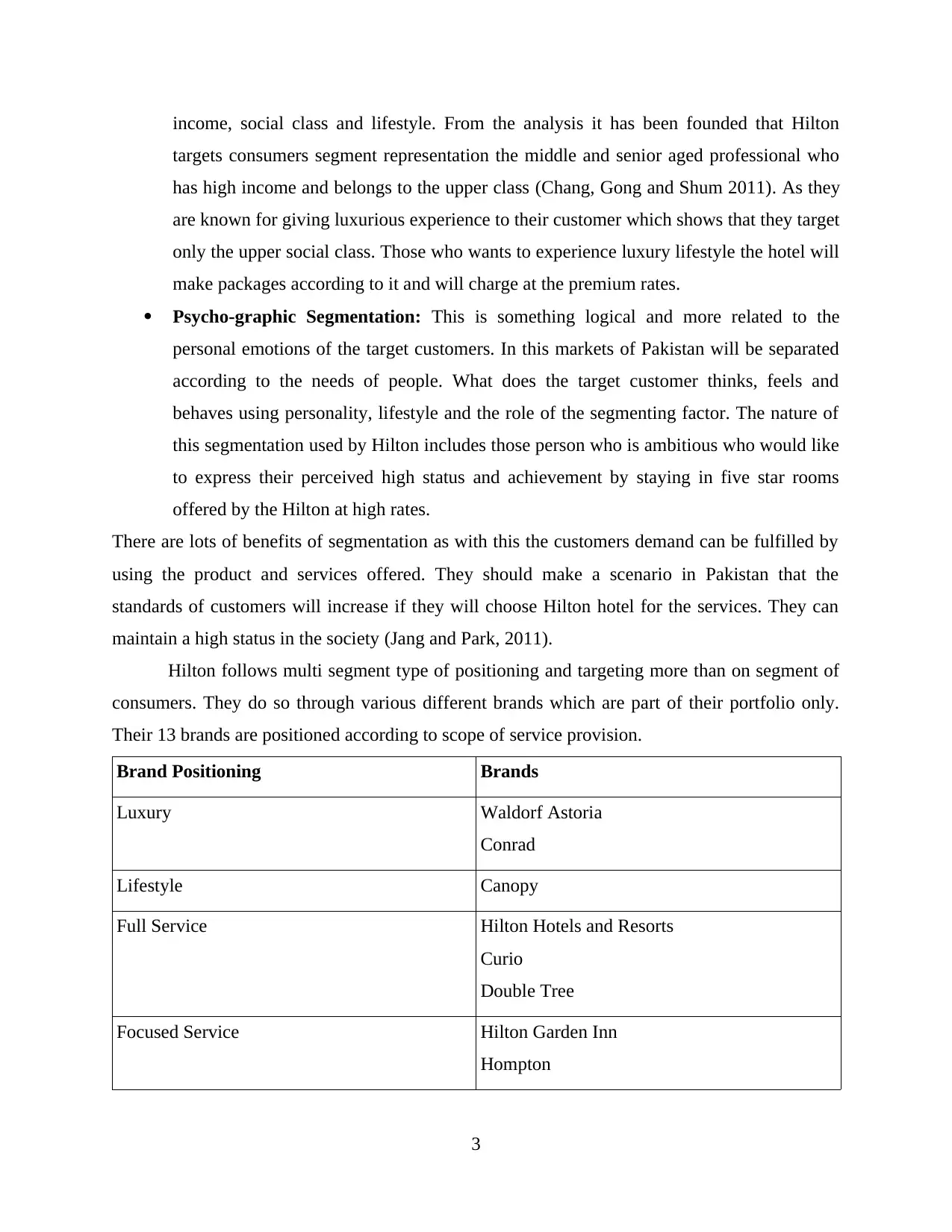
income, social class and lifestyle. From the analysis it has been founded that Hilton
targets consumers segment representation the middle and senior aged professional who
has high income and belongs to the upper class (Chang, Gong and Shum 2011). As they
are known for giving luxurious experience to their customer which shows that they target
only the upper social class. Those who wants to experience luxury lifestyle the hotel will
make packages according to it and will charge at the premium rates.
Psycho-graphic Segmentation: This is something logical and more related to the
personal emotions of the target customers. In this markets of Pakistan will be separated
according to the needs of people. What does the target customer thinks, feels and
behaves using personality, lifestyle and the role of the segmenting factor. The nature of
this segmentation used by Hilton includes those person who is ambitious who would like
to express their perceived high status and achievement by staying in five star rooms
offered by the Hilton at high rates.
There are lots of benefits of segmentation as with this the customers demand can be fulfilled by
using the product and services offered. They should make a scenario in Pakistan that the
standards of customers will increase if they will choose Hilton hotel for the services. They can
maintain a high status in the society (Jang and Park, 2011).
Hilton follows multi segment type of positioning and targeting more than on segment of
consumers. They do so through various different brands which are part of their portfolio only.
Their 13 brands are positioned according to scope of service provision.
Brand Positioning Brands
Luxury Waldorf Astoria
Conrad
Lifestyle Canopy
Full Service Hilton Hotels and Resorts
Curio
Double Tree
Focused Service Hilton Garden Inn
Hompton
3
targets consumers segment representation the middle and senior aged professional who
has high income and belongs to the upper class (Chang, Gong and Shum 2011). As they
are known for giving luxurious experience to their customer which shows that they target
only the upper social class. Those who wants to experience luxury lifestyle the hotel will
make packages according to it and will charge at the premium rates.
Psycho-graphic Segmentation: This is something logical and more related to the
personal emotions of the target customers. In this markets of Pakistan will be separated
according to the needs of people. What does the target customer thinks, feels and
behaves using personality, lifestyle and the role of the segmenting factor. The nature of
this segmentation used by Hilton includes those person who is ambitious who would like
to express their perceived high status and achievement by staying in five star rooms
offered by the Hilton at high rates.
There are lots of benefits of segmentation as with this the customers demand can be fulfilled by
using the product and services offered. They should make a scenario in Pakistan that the
standards of customers will increase if they will choose Hilton hotel for the services. They can
maintain a high status in the society (Jang and Park, 2011).
Hilton follows multi segment type of positioning and targeting more than on segment of
consumers. They do so through various different brands which are part of their portfolio only.
Their 13 brands are positioned according to scope of service provision.
Brand Positioning Brands
Luxury Waldorf Astoria
Conrad
Lifestyle Canopy
Full Service Hilton Hotels and Resorts
Curio
Double Tree
Focused Service Hilton Garden Inn
Hompton
3

Tru
All Suites Homeswood Suites
Embassy Suites
Home2
Vacation Ownership Hilton Grand Vacations
To make sure all is going well in Hilton the management of the company should conduct
a SWOT analysis of their hotel chain. SWOT is the strengths, weaknesses, opportunities and
threats of an organisation. Hilton group also has some strength and weakness.
Strengths:
It is a big hotel brand in the world and today it has 13 brands who are doing business
under his name. On an average they give their services to almost 140 million traveller in
more than 100 countries. This was the data from the 2015 annual report. They earn lots of
benefits form the economies of scale because their business operations are large in
number. This also paves the path for the growth of the business (Ip, Leung and Law,
2011).
They have made their mark in this industry and one of the reason behind this is their
Hilton Honours program which was kind of customer loyalty schemes in the industry.
With this the programs offered low prices, digital check- in, Wi-Fi free of cost and etc.
This has made better image of the Hilton group in the eyes of their customers.
There are almost 4610 properties of Hilton all across the world. This gives certain
advantage to them on their financial side. The biggest advantage of this is that they don't
need to pay for the rent and does not need to take properties on lease. Such thing will
reduces the operational costs through these steps. Hilton Group can also sell some part of
the land he they feel that they are urge on the bankruptcy.
Leadership of Hilton Group is in the hands of individuals who are flexible in working
anywhere and knows how to tackle difficult situation at the time of crises. For making
sure that all the group members follow the organisational sculpture and works more
effectively they conduct training, seminars on regular basis (Law, Buhalis and
4
All Suites Homeswood Suites
Embassy Suites
Home2
Vacation Ownership Hilton Grand Vacations
To make sure all is going well in Hilton the management of the company should conduct
a SWOT analysis of their hotel chain. SWOT is the strengths, weaknesses, opportunities and
threats of an organisation. Hilton group also has some strength and weakness.
Strengths:
It is a big hotel brand in the world and today it has 13 brands who are doing business
under his name. On an average they give their services to almost 140 million traveller in
more than 100 countries. This was the data from the 2015 annual report. They earn lots of
benefits form the economies of scale because their business operations are large in
number. This also paves the path for the growth of the business (Ip, Leung and Law,
2011).
They have made their mark in this industry and one of the reason behind this is their
Hilton Honours program which was kind of customer loyalty schemes in the industry.
With this the programs offered low prices, digital check- in, Wi-Fi free of cost and etc.
This has made better image of the Hilton group in the eyes of their customers.
There are almost 4610 properties of Hilton all across the world. This gives certain
advantage to them on their financial side. The biggest advantage of this is that they don't
need to pay for the rent and does not need to take properties on lease. Such thing will
reduces the operational costs through these steps. Hilton Group can also sell some part of
the land he they feel that they are urge on the bankruptcy.
Leadership of Hilton Group is in the hands of individuals who are flexible in working
anywhere and knows how to tackle difficult situation at the time of crises. For making
sure that all the group members follow the organisational sculpture and works more
effectively they conduct training, seminars on regular basis (Law, Buhalis and
4
Paraphrase This Document
Need a fresh take? Get an instant paraphrase of this document with our AI Paraphraser
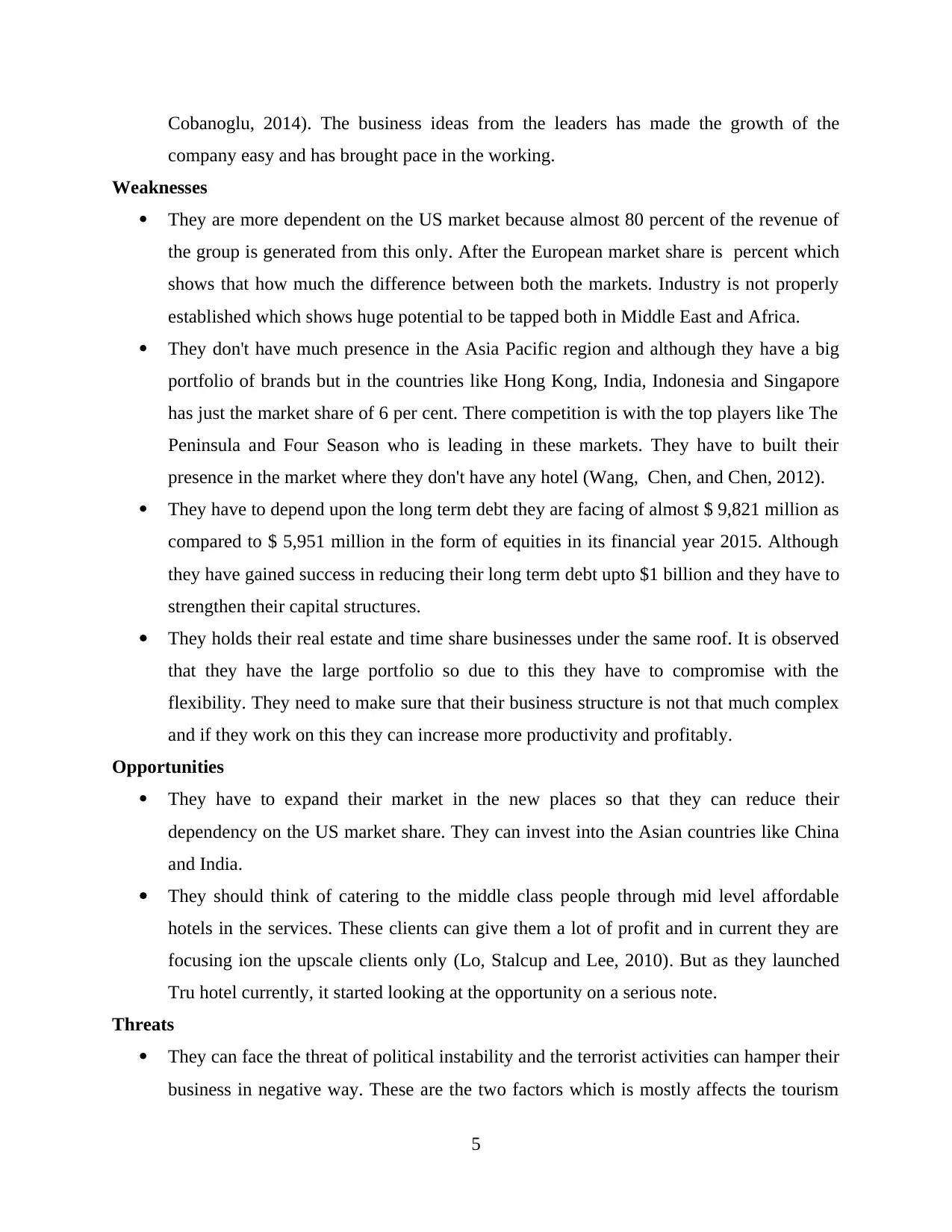
Cobanoglu, 2014). The business ideas from the leaders has made the growth of the
company easy and has brought pace in the working.
Weaknesses
They are more dependent on the US market because almost 80 percent of the revenue of
the group is generated from this only. After the European market share is percent which
shows that how much the difference between both the markets. Industry is not properly
established which shows huge potential to be tapped both in Middle East and Africa.
They don't have much presence in the Asia Pacific region and although they have a big
portfolio of brands but in the countries like Hong Kong, India, Indonesia and Singapore
has just the market share of 6 per cent. There competition is with the top players like The
Peninsula and Four Season who is leading in these markets. They have to built their
presence in the market where they don't have any hotel (Wang, Chen, and Chen, 2012).
They have to depend upon the long term debt they are facing of almost $ 9,821 million as
compared to $ 5,951 million in the form of equities in its financial year 2015. Although
they have gained success in reducing their long term debt upto $1 billion and they have to
strengthen their capital structures.
They holds their real estate and time share businesses under the same roof. It is observed
that they have the large portfolio so due to this they have to compromise with the
flexibility. They need to make sure that their business structure is not that much complex
and if they work on this they can increase more productivity and profitably.
Opportunities
They have to expand their market in the new places so that they can reduce their
dependency on the US market share. They can invest into the Asian countries like China
and India.
They should think of catering to the middle class people through mid level affordable
hotels in the services. These clients can give them a lot of profit and in current they are
focusing ion the upscale clients only (Lo, Stalcup and Lee, 2010). But as they launched
Tru hotel currently, it started looking at the opportunity on a serious note.
Threats
They can face the threat of political instability and the terrorist activities can hamper their
business in negative way. These are the two factors which is mostly affects the tourism
5
company easy and has brought pace in the working.
Weaknesses
They are more dependent on the US market because almost 80 percent of the revenue of
the group is generated from this only. After the European market share is percent which
shows that how much the difference between both the markets. Industry is not properly
established which shows huge potential to be tapped both in Middle East and Africa.
They don't have much presence in the Asia Pacific region and although they have a big
portfolio of brands but in the countries like Hong Kong, India, Indonesia and Singapore
has just the market share of 6 per cent. There competition is with the top players like The
Peninsula and Four Season who is leading in these markets. They have to built their
presence in the market where they don't have any hotel (Wang, Chen, and Chen, 2012).
They have to depend upon the long term debt they are facing of almost $ 9,821 million as
compared to $ 5,951 million in the form of equities in its financial year 2015. Although
they have gained success in reducing their long term debt upto $1 billion and they have to
strengthen their capital structures.
They holds their real estate and time share businesses under the same roof. It is observed
that they have the large portfolio so due to this they have to compromise with the
flexibility. They need to make sure that their business structure is not that much complex
and if they work on this they can increase more productivity and profitably.
Opportunities
They have to expand their market in the new places so that they can reduce their
dependency on the US market share. They can invest into the Asian countries like China
and India.
They should think of catering to the middle class people through mid level affordable
hotels in the services. These clients can give them a lot of profit and in current they are
focusing ion the upscale clients only (Lo, Stalcup and Lee, 2010). But as they launched
Tru hotel currently, it started looking at the opportunity on a serious note.
Threats
They can face the threat of political instability and the terrorist activities can hamper their
business in negative way. These are the two factors which is mostly affects the tourism
5
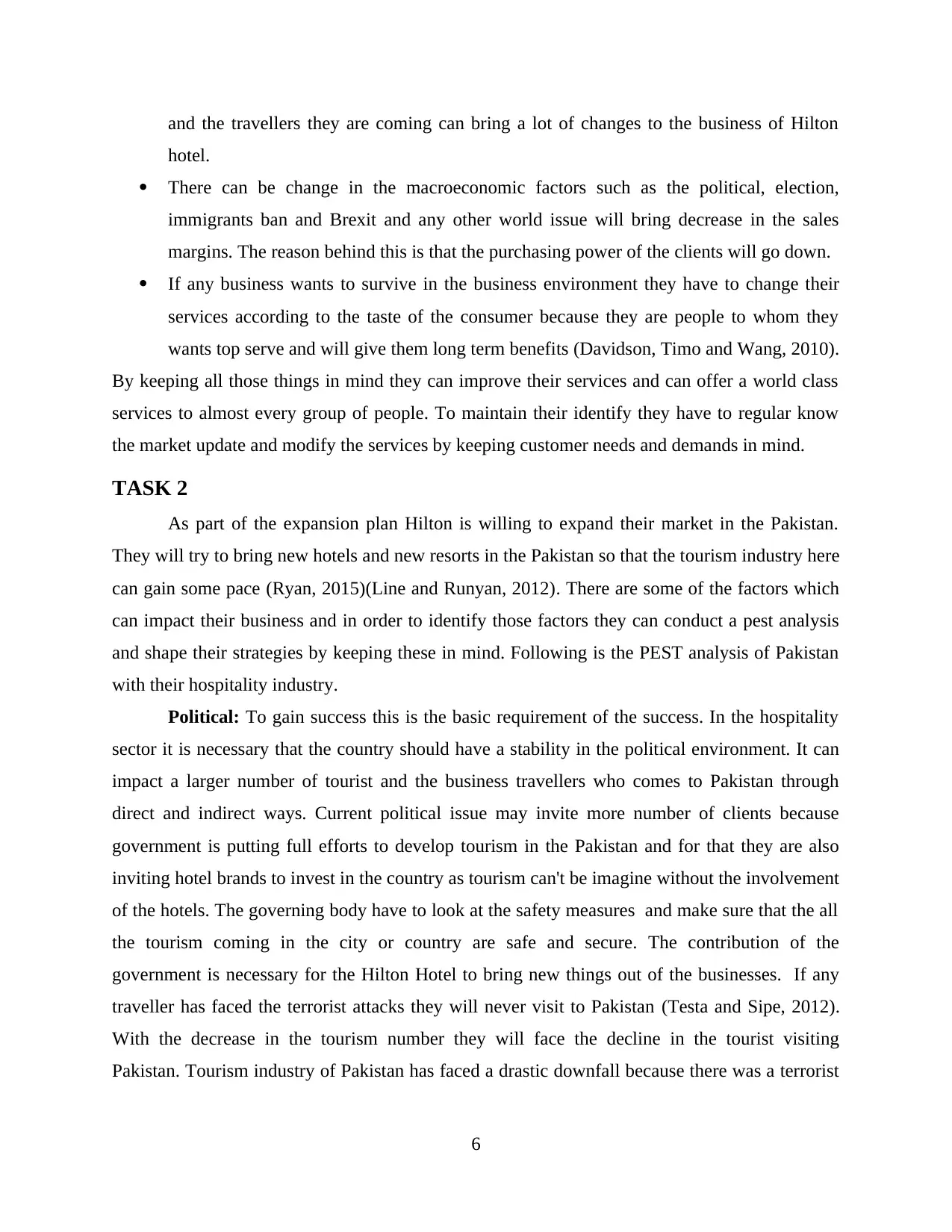
and the travellers they are coming can bring a lot of changes to the business of Hilton
hotel.
There can be change in the macroeconomic factors such as the political, election,
immigrants ban and Brexit and any other world issue will bring decrease in the sales
margins. The reason behind this is that the purchasing power of the clients will go down.
If any business wants to survive in the business environment they have to change their
services according to the taste of the consumer because they are people to whom they
wants top serve and will give them long term benefits (Davidson, Timo and Wang, 2010).
By keeping all those things in mind they can improve their services and can offer a world class
services to almost every group of people. To maintain their identify they have to regular know
the market update and modify the services by keeping customer needs and demands in mind.
TASK 2
As part of the expansion plan Hilton is willing to expand their market in the Pakistan.
They will try to bring new hotels and new resorts in the Pakistan so that the tourism industry here
can gain some pace (Ryan, 2015)(Line and Runyan, 2012). There are some of the factors which
can impact their business and in order to identify those factors they can conduct a pest analysis
and shape their strategies by keeping these in mind. Following is the PEST analysis of Pakistan
with their hospitality industry.
Political: To gain success this is the basic requirement of the success. In the hospitality
sector it is necessary that the country should have a stability in the political environment. It can
impact a larger number of tourist and the business travellers who comes to Pakistan through
direct and indirect ways. Current political issue may invite more number of clients because
government is putting full efforts to develop tourism in the Pakistan and for that they are also
inviting hotel brands to invest in the country as tourism can't be imagine without the involvement
of the hotels. The governing body have to look at the safety measures and make sure that the all
the tourism coming in the city or country are safe and secure. The contribution of the
government is necessary for the Hilton Hotel to bring new things out of the businesses. If any
traveller has faced the terrorist attacks they will never visit to Pakistan (Testa and Sipe, 2012).
With the decrease in the tourism number they will face the decline in the tourist visiting
Pakistan. Tourism industry of Pakistan has faced a drastic downfall because there was a terrorist
6
hotel.
There can be change in the macroeconomic factors such as the political, election,
immigrants ban and Brexit and any other world issue will bring decrease in the sales
margins. The reason behind this is that the purchasing power of the clients will go down.
If any business wants to survive in the business environment they have to change their
services according to the taste of the consumer because they are people to whom they
wants top serve and will give them long term benefits (Davidson, Timo and Wang, 2010).
By keeping all those things in mind they can improve their services and can offer a world class
services to almost every group of people. To maintain their identify they have to regular know
the market update and modify the services by keeping customer needs and demands in mind.
TASK 2
As part of the expansion plan Hilton is willing to expand their market in the Pakistan.
They will try to bring new hotels and new resorts in the Pakistan so that the tourism industry here
can gain some pace (Ryan, 2015)(Line and Runyan, 2012). There are some of the factors which
can impact their business and in order to identify those factors they can conduct a pest analysis
and shape their strategies by keeping these in mind. Following is the PEST analysis of Pakistan
with their hospitality industry.
Political: To gain success this is the basic requirement of the success. In the hospitality
sector it is necessary that the country should have a stability in the political environment. It can
impact a larger number of tourist and the business travellers who comes to Pakistan through
direct and indirect ways. Current political issue may invite more number of clients because
government is putting full efforts to develop tourism in the Pakistan and for that they are also
inviting hotel brands to invest in the country as tourism can't be imagine without the involvement
of the hotels. The governing body have to look at the safety measures and make sure that the all
the tourism coming in the city or country are safe and secure. The contribution of the
government is necessary for the Hilton Hotel to bring new things out of the businesses. If any
traveller has faced the terrorist attacks they will never visit to Pakistan (Testa and Sipe, 2012).
With the decrease in the tourism number they will face the decline in the tourist visiting
Pakistan. Tourism industry of Pakistan has faced a drastic downfall because there was a terrorist
6

attack in 2010 when their competitor Marriott in Islamabad was under the terror bombing. This
hit them it great
Economic Factor: National and international macroeconomic situation and factors and
events influencing the situation are crucial factors affecting Hilton hotels business. At time
come when the hotels can be crowded but after the season most of them will be vacant. This will
affect their business operations. Normally in Pakistan winters is the season when tourist goes for
travel. As the country is unstable this can bring a lot of trouble for them. To avoid such condition
they have to adapt their strategy according to it because this make their tasks easier. During the
economic crises of 2007-2009 their sales went down and they were in lane to change close down
their some of the hotels and resorts. The economy of the Pakistan has to face a lot challenges
because government is failing in investing into the infrastructure development. It took life of 50
people and injuring almost 250 (Gill and et. al., 2010). This incident had brought the tourism
activity down because the
the foreign tourist felt uncomfortable to the country where they feel that their life in danger.
Socio Culture Factors: It includes all the factors which are related to the lifestyle of the
people. Pakistan is the country where youth population is there and there population growth rate
is increasing. On what amenities people spend most in the hotels can be analysed and after that
Hilton hotel should focus on the various ways they can provide that amenities with maximum
benefit. Normally the population of the Pakistan is not literate and most of the them lives in the
rural area so opening much hotels here would give them losses. They can open their hotel in
Karachi which is the commercial capital of Pakistan. Hilton will bring hotel which is in medium
range and targeting the consumer belonging to the medium class.
Technological Factor:- There is less technological advancement in the hospitality sector
of Pakistan. If anyone has who brings a new things which involves any kind of innovation and
has some value attached to it. This will help them in gaining competitive advantage from this
rivals. They have to set their team and ask them to fully analyse the market and come with the
innovations which can set new heights in the hospitality sector (Tsang and Hsu, 2011). Pakistan
is a new market which has lots of scopes so they should also look at the places where they can
bring their resorts.
It is observed that every country has different external business environment so those
hotels who wants to expand their business first need to identify them and analyse how they can
7
hit them it great
Economic Factor: National and international macroeconomic situation and factors and
events influencing the situation are crucial factors affecting Hilton hotels business. At time
come when the hotels can be crowded but after the season most of them will be vacant. This will
affect their business operations. Normally in Pakistan winters is the season when tourist goes for
travel. As the country is unstable this can bring a lot of trouble for them. To avoid such condition
they have to adapt their strategy according to it because this make their tasks easier. During the
economic crises of 2007-2009 their sales went down and they were in lane to change close down
their some of the hotels and resorts. The economy of the Pakistan has to face a lot challenges
because government is failing in investing into the infrastructure development. It took life of 50
people and injuring almost 250 (Gill and et. al., 2010). This incident had brought the tourism
activity down because the
the foreign tourist felt uncomfortable to the country where they feel that their life in danger.
Socio Culture Factors: It includes all the factors which are related to the lifestyle of the
people. Pakistan is the country where youth population is there and there population growth rate
is increasing. On what amenities people spend most in the hotels can be analysed and after that
Hilton hotel should focus on the various ways they can provide that amenities with maximum
benefit. Normally the population of the Pakistan is not literate and most of the them lives in the
rural area so opening much hotels here would give them losses. They can open their hotel in
Karachi which is the commercial capital of Pakistan. Hilton will bring hotel which is in medium
range and targeting the consumer belonging to the medium class.
Technological Factor:- There is less technological advancement in the hospitality sector
of Pakistan. If anyone has who brings a new things which involves any kind of innovation and
has some value attached to it. This will help them in gaining competitive advantage from this
rivals. They have to set their team and ask them to fully analyse the market and come with the
innovations which can set new heights in the hospitality sector (Tsang and Hsu, 2011). Pakistan
is a new market which has lots of scopes so they should also look at the places where they can
bring their resorts.
It is observed that every country has different external business environment so those
hotels who wants to expand their business first need to identify them and analyse how they can
7
Secure Best Marks with AI Grader
Need help grading? Try our AI Grader for instant feedback on your assignments.
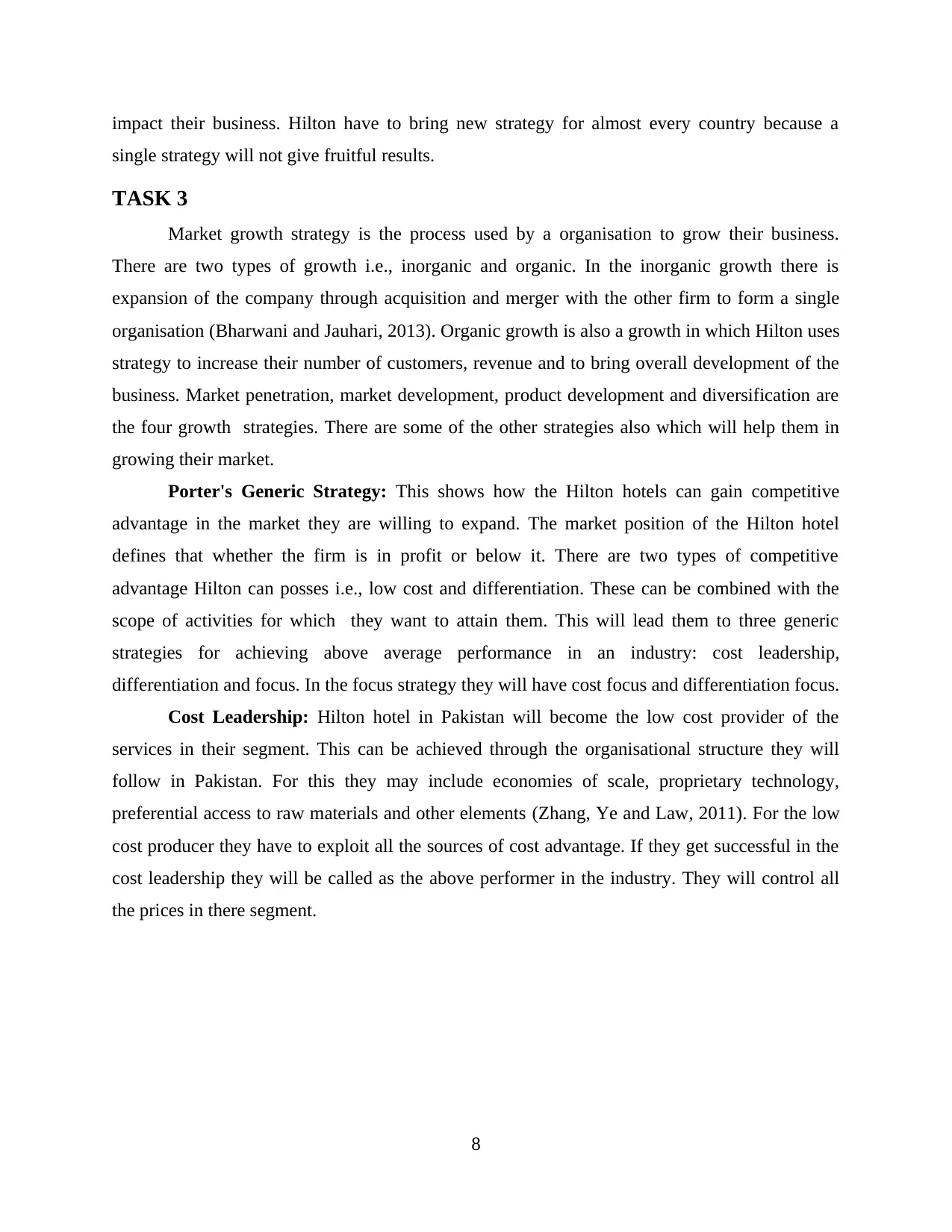
impact their business. Hilton have to bring new strategy for almost every country because a
single strategy will not give fruitful results.
TASK 3
Market growth strategy is the process used by a organisation to grow their business.
There are two types of growth i.e., inorganic and organic. In the inorganic growth there is
expansion of the company through acquisition and merger with the other firm to form a single
organisation (Bharwani and Jauhari, 2013). Organic growth is also a growth in which Hilton uses
strategy to increase their number of customers, revenue and to bring overall development of the
business. Market penetration, market development, product development and diversification are
the four growth strategies. There are some of the other strategies also which will help them in
growing their market.
Porter's Generic Strategy: This shows how the Hilton hotels can gain competitive
advantage in the market they are willing to expand. The market position of the Hilton hotel
defines that whether the firm is in profit or below it. There are two types of competitive
advantage Hilton can posses i.e., low cost and differentiation. These can be combined with the
scope of activities for which they want to attain them. This will lead them to three generic
strategies for achieving above average performance in an industry: cost leadership,
differentiation and focus. In the focus strategy they will have cost focus and differentiation focus.
Cost Leadership: Hilton hotel in Pakistan will become the low cost provider of the
services in their segment. This can be achieved through the organisational structure they will
follow in Pakistan. For this they may include economies of scale, proprietary technology,
preferential access to raw materials and other elements (Zhang, Ye and Law, 2011). For the low
cost producer they have to exploit all the sources of cost advantage. If they get successful in the
cost leadership they will be called as the above performer in the industry. They will control all
the prices in there segment.
8
single strategy will not give fruitful results.
TASK 3
Market growth strategy is the process used by a organisation to grow their business.
There are two types of growth i.e., inorganic and organic. In the inorganic growth there is
expansion of the company through acquisition and merger with the other firm to form a single
organisation (Bharwani and Jauhari, 2013). Organic growth is also a growth in which Hilton uses
strategy to increase their number of customers, revenue and to bring overall development of the
business. Market penetration, market development, product development and diversification are
the four growth strategies. There are some of the other strategies also which will help them in
growing their market.
Porter's Generic Strategy: This shows how the Hilton hotels can gain competitive
advantage in the market they are willing to expand. The market position of the Hilton hotel
defines that whether the firm is in profit or below it. There are two types of competitive
advantage Hilton can posses i.e., low cost and differentiation. These can be combined with the
scope of activities for which they want to attain them. This will lead them to three generic
strategies for achieving above average performance in an industry: cost leadership,
differentiation and focus. In the focus strategy they will have cost focus and differentiation focus.
Cost Leadership: Hilton hotel in Pakistan will become the low cost provider of the
services in their segment. This can be achieved through the organisational structure they will
follow in Pakistan. For this they may include economies of scale, proprietary technology,
preferential access to raw materials and other elements (Zhang, Ye and Law, 2011). For the low
cost producer they have to exploit all the sources of cost advantage. If they get successful in the
cost leadership they will be called as the above performer in the industry. They will control all
the prices in there segment.
8
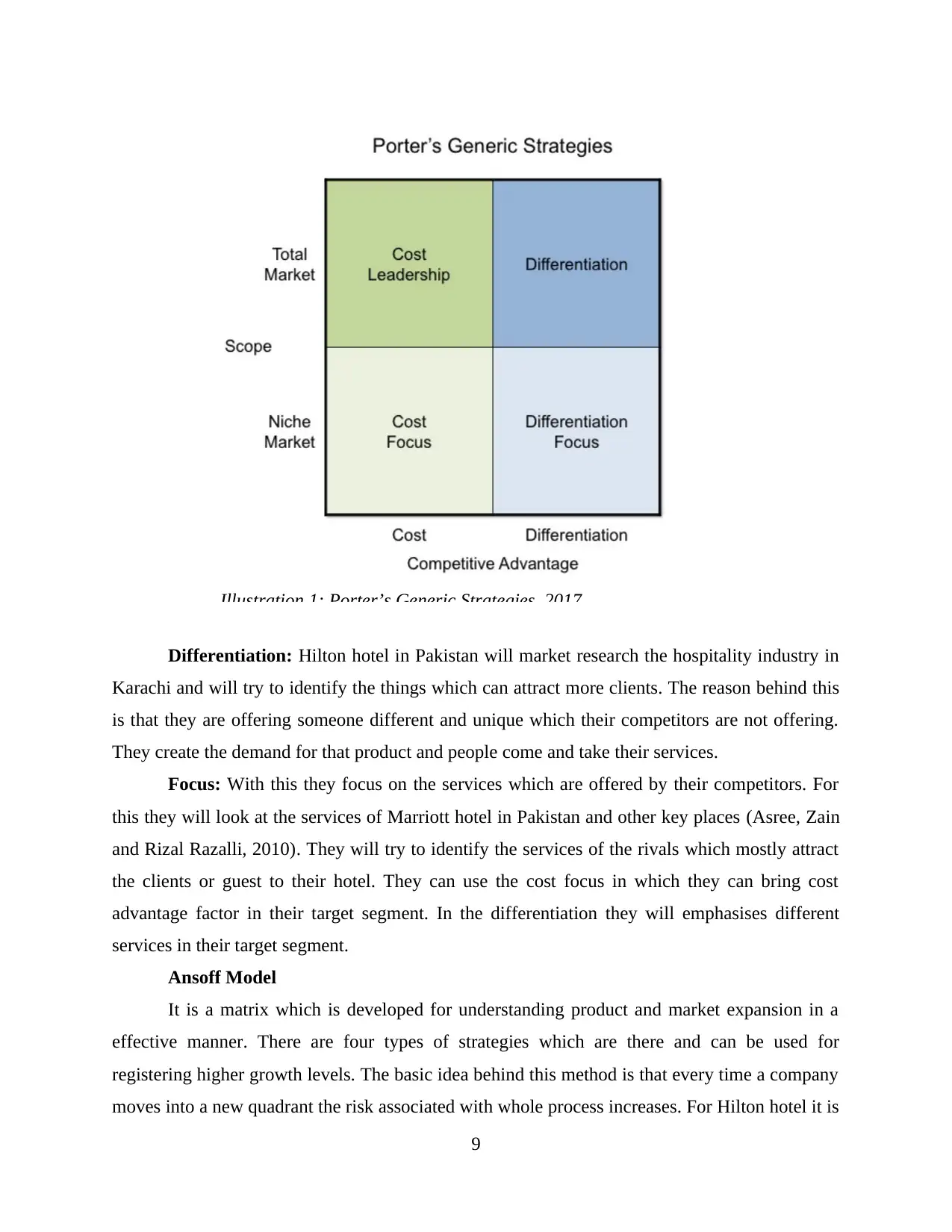
Differentiation: Hilton hotel in Pakistan will market research the hospitality industry in
Karachi and will try to identify the things which can attract more clients. The reason behind this
is that they are offering someone different and unique which their competitors are not offering.
They create the demand for that product and people come and take their services.
Focus: With this they focus on the services which are offered by their competitors. For
this they will look at the services of Marriott hotel in Pakistan and other key places (Asree, Zain
and Rizal Razalli, 2010). They will try to identify the services of the rivals which mostly attract
the clients or guest to their hotel. They can use the cost focus in which they can bring cost
advantage factor in their target segment. In the differentiation they will emphasises different
services in their target segment.
Ansoff Model
It is a matrix which is developed for understanding product and market expansion in a
effective manner. There are four types of strategies which are there and can be used for
registering higher growth levels. The basic idea behind this method is that every time a company
moves into a new quadrant the risk associated with whole process increases. For Hilton hotel it is
9
Illustration 1: Porter’s Generic Strategies, 2017
Karachi and will try to identify the things which can attract more clients. The reason behind this
is that they are offering someone different and unique which their competitors are not offering.
They create the demand for that product and people come and take their services.
Focus: With this they focus on the services which are offered by their competitors. For
this they will look at the services of Marriott hotel in Pakistan and other key places (Asree, Zain
and Rizal Razalli, 2010). They will try to identify the services of the rivals which mostly attract
the clients or guest to their hotel. They can use the cost focus in which they can bring cost
advantage factor in their target segment. In the differentiation they will emphasises different
services in their target segment.
Ansoff Model
It is a matrix which is developed for understanding product and market expansion in a
effective manner. There are four types of strategies which are there and can be used for
registering higher growth levels. The basic idea behind this method is that every time a company
moves into a new quadrant the risk associated with whole process increases. For Hilton hotel it is
9
Illustration 1: Porter’s Generic Strategies, 2017
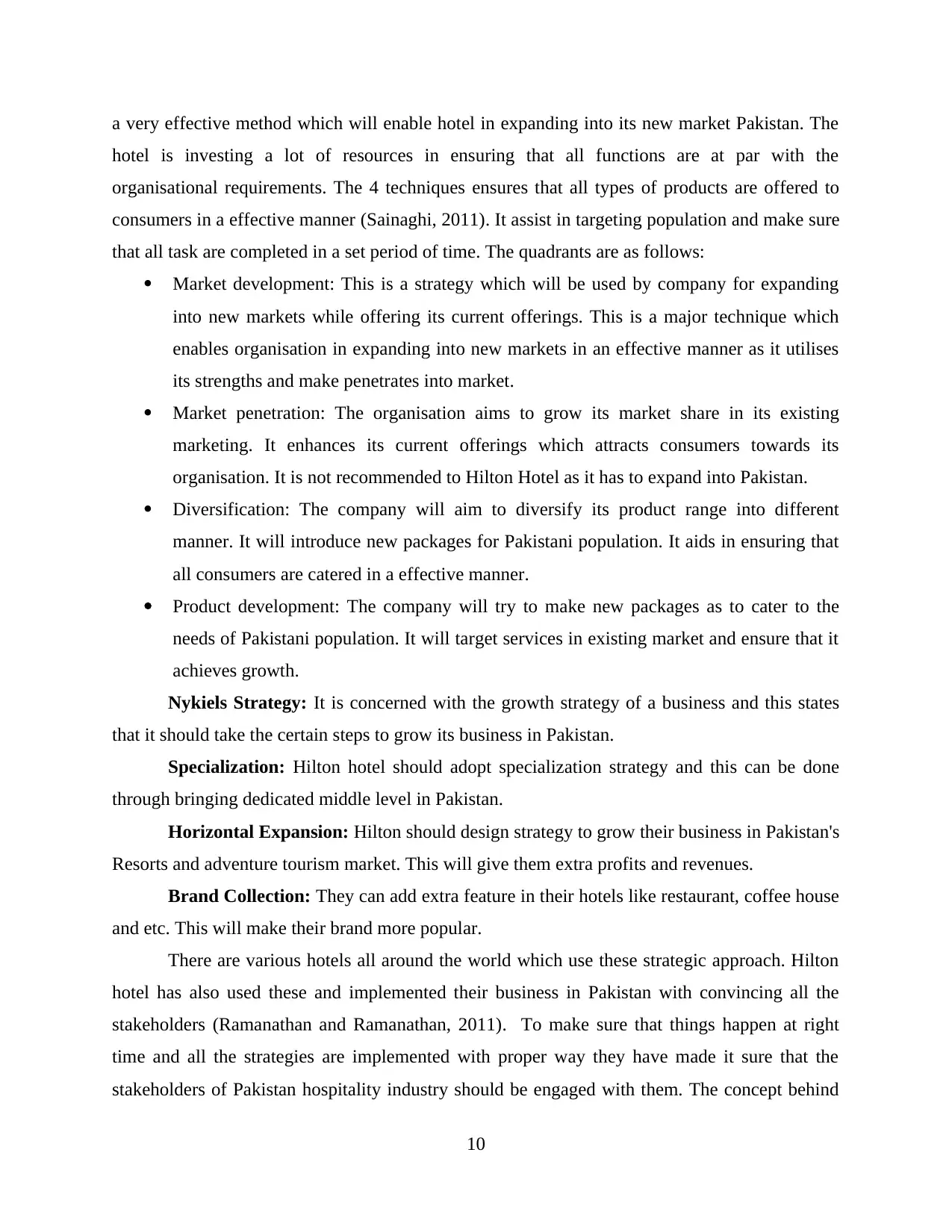
a very effective method which will enable hotel in expanding into its new market Pakistan. The
hotel is investing a lot of resources in ensuring that all functions are at par with the
organisational requirements. The 4 techniques ensures that all types of products are offered to
consumers in a effective manner (Sainaghi, 2011). It assist in targeting population and make sure
that all task are completed in a set period of time. The quadrants are as follows:
Market development: This is a strategy which will be used by company for expanding
into new markets while offering its current offerings. This is a major technique which
enables organisation in expanding into new markets in an effective manner as it utilises
its strengths and make penetrates into market.
Market penetration: The organisation aims to grow its market share in its existing
marketing. It enhances its current offerings which attracts consumers towards its
organisation. It is not recommended to Hilton Hotel as it has to expand into Pakistan.
Diversification: The company will aim to diversify its product range into different
manner. It will introduce new packages for Pakistani population. It aids in ensuring that
all consumers are catered in a effective manner.
Product development: The company will try to make new packages as to cater to the
needs of Pakistani population. It will target services in existing market and ensure that it
achieves growth.
Nykiels Strategy: It is concerned with the growth strategy of a business and this states
that it should take the certain steps to grow its business in Pakistan.
Specialization: Hilton hotel should adopt specialization strategy and this can be done
through bringing dedicated middle level in Pakistan.
Horizontal Expansion: Hilton should design strategy to grow their business in Pakistan's
Resorts and adventure tourism market. This will give them extra profits and revenues.
Brand Collection: They can add extra feature in their hotels like restaurant, coffee house
and etc. This will make their brand more popular.
There are various hotels all around the world which use these strategic approach. Hilton
hotel has also used these and implemented their business in Pakistan with convincing all the
stakeholders (Ramanathan and Ramanathan, 2011). To make sure that things happen at right
time and all the strategies are implemented with proper way they have made it sure that the
stakeholders of Pakistan hospitality industry should be engaged with them. The concept behind
10
hotel is investing a lot of resources in ensuring that all functions are at par with the
organisational requirements. The 4 techniques ensures that all types of products are offered to
consumers in a effective manner (Sainaghi, 2011). It assist in targeting population and make sure
that all task are completed in a set period of time. The quadrants are as follows:
Market development: This is a strategy which will be used by company for expanding
into new markets while offering its current offerings. This is a major technique which
enables organisation in expanding into new markets in an effective manner as it utilises
its strengths and make penetrates into market.
Market penetration: The organisation aims to grow its market share in its existing
marketing. It enhances its current offerings which attracts consumers towards its
organisation. It is not recommended to Hilton Hotel as it has to expand into Pakistan.
Diversification: The company will aim to diversify its product range into different
manner. It will introduce new packages for Pakistani population. It aids in ensuring that
all consumers are catered in a effective manner.
Product development: The company will try to make new packages as to cater to the
needs of Pakistani population. It will target services in existing market and ensure that it
achieves growth.
Nykiels Strategy: It is concerned with the growth strategy of a business and this states
that it should take the certain steps to grow its business in Pakistan.
Specialization: Hilton hotel should adopt specialization strategy and this can be done
through bringing dedicated middle level in Pakistan.
Horizontal Expansion: Hilton should design strategy to grow their business in Pakistan's
Resorts and adventure tourism market. This will give them extra profits and revenues.
Brand Collection: They can add extra feature in their hotels like restaurant, coffee house
and etc. This will make their brand more popular.
There are various hotels all around the world which use these strategic approach. Hilton
hotel has also used these and implemented their business in Pakistan with convincing all the
stakeholders (Ramanathan and Ramanathan, 2011). To make sure that things happen at right
time and all the strategies are implemented with proper way they have made it sure that the
stakeholders of Pakistan hospitality industry should be engaged with them. The concept behind
10
Paraphrase This Document
Need a fresh take? Get an instant paraphrase of this document with our AI Paraphraser
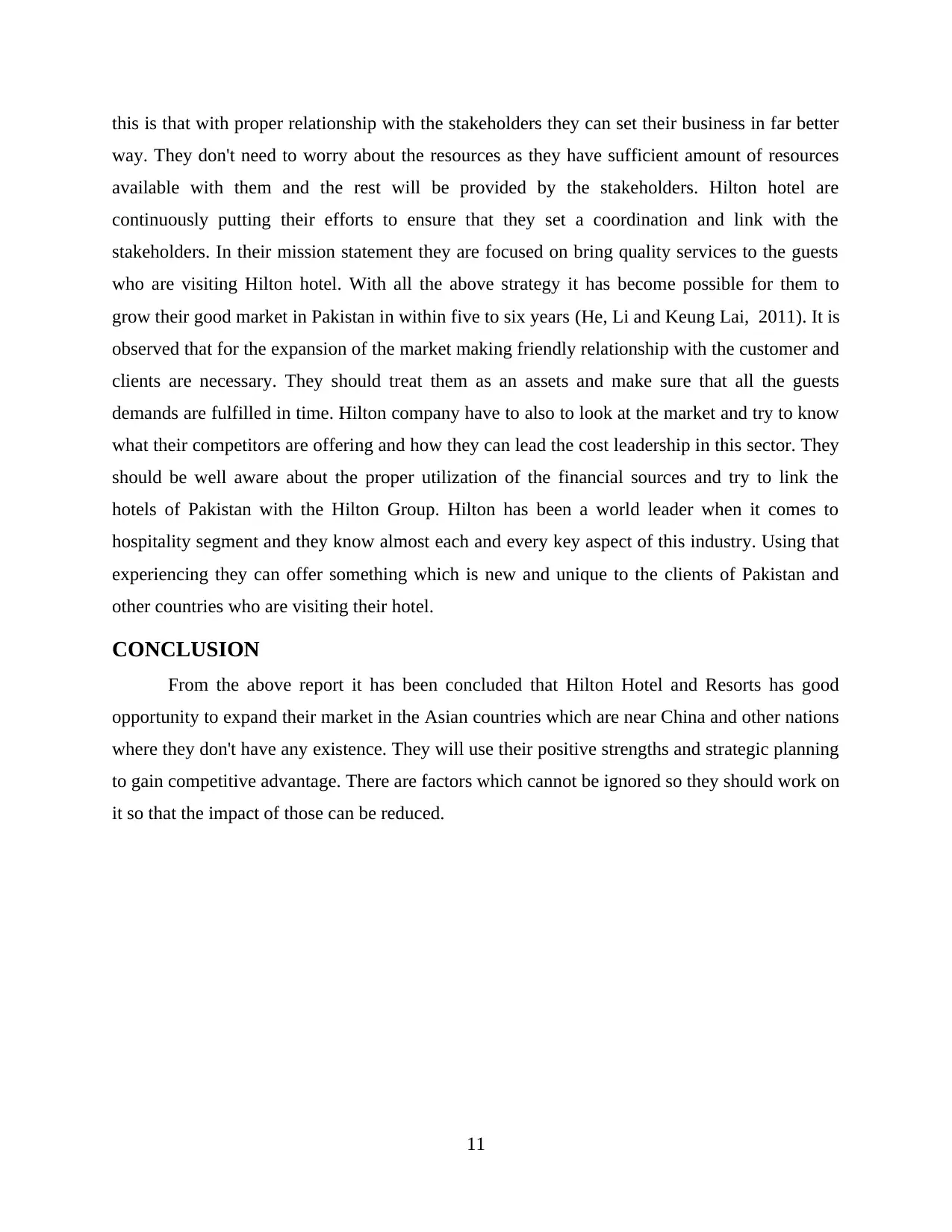
this is that with proper relationship with the stakeholders they can set their business in far better
way. They don't need to worry about the resources as they have sufficient amount of resources
available with them and the rest will be provided by the stakeholders. Hilton hotel are
continuously putting their efforts to ensure that they set a coordination and link with the
stakeholders. In their mission statement they are focused on bring quality services to the guests
who are visiting Hilton hotel. With all the above strategy it has become possible for them to
grow their good market in Pakistan in within five to six years (He, Li and Keung Lai, 2011). It is
observed that for the expansion of the market making friendly relationship with the customer and
clients are necessary. They should treat them as an assets and make sure that all the guests
demands are fulfilled in time. Hilton company have to also to look at the market and try to know
what their competitors are offering and how they can lead the cost leadership in this sector. They
should be well aware about the proper utilization of the financial sources and try to link the
hotels of Pakistan with the Hilton Group. Hilton has been a world leader when it comes to
hospitality segment and they know almost each and every key aspect of this industry. Using that
experiencing they can offer something which is new and unique to the clients of Pakistan and
other countries who are visiting their hotel.
CONCLUSION
From the above report it has been concluded that Hilton Hotel and Resorts has good
opportunity to expand their market in the Asian countries which are near China and other nations
where they don't have any existence. They will use their positive strengths and strategic planning
to gain competitive advantage. There are factors which cannot be ignored so they should work on
it so that the impact of those can be reduced.
11
way. They don't need to worry about the resources as they have sufficient amount of resources
available with them and the rest will be provided by the stakeholders. Hilton hotel are
continuously putting their efforts to ensure that they set a coordination and link with the
stakeholders. In their mission statement they are focused on bring quality services to the guests
who are visiting Hilton hotel. With all the above strategy it has become possible for them to
grow their good market in Pakistan in within five to six years (He, Li and Keung Lai, 2011). It is
observed that for the expansion of the market making friendly relationship with the customer and
clients are necessary. They should treat them as an assets and make sure that all the guests
demands are fulfilled in time. Hilton company have to also to look at the market and try to know
what their competitors are offering and how they can lead the cost leadership in this sector. They
should be well aware about the proper utilization of the financial sources and try to link the
hotels of Pakistan with the Hilton Group. Hilton has been a world leader when it comes to
hospitality segment and they know almost each and every key aspect of this industry. Using that
experiencing they can offer something which is new and unique to the clients of Pakistan and
other countries who are visiting their hotel.
CONCLUSION
From the above report it has been concluded that Hilton Hotel and Resorts has good
opportunity to expand their market in the Asian countries which are near China and other nations
where they don't have any existence. They will use their positive strengths and strategic planning
to gain competitive advantage. There are factors which cannot be ignored so they should work on
it so that the impact of those can be reduced.
11
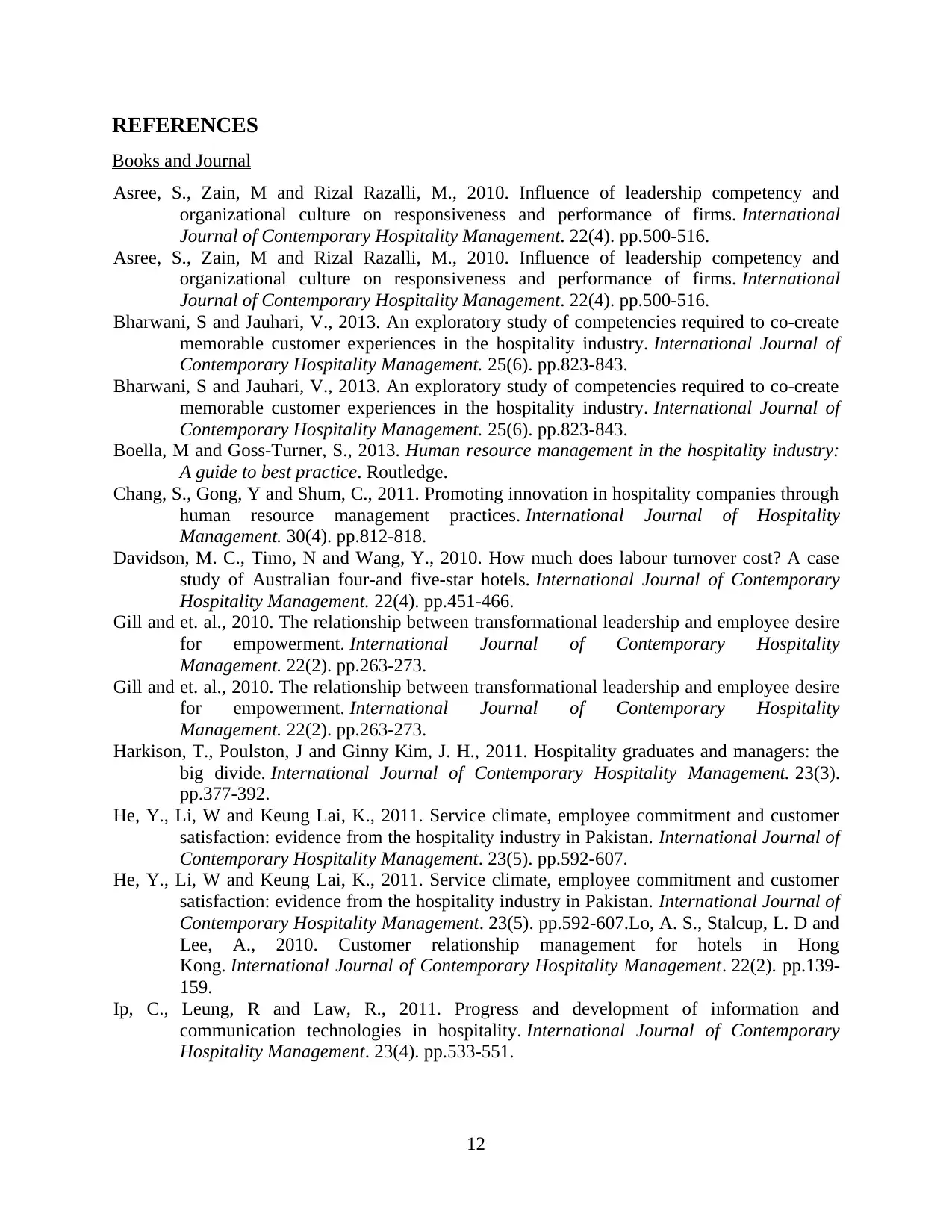
REFERENCES
Books and Journal
Asree, S., Zain, M and Rizal Razalli, M., 2010. Influence of leadership competency and
organizational culture on responsiveness and performance of firms. International
Journal of Contemporary Hospitality Management. 22(4). pp.500-516.
Asree, S., Zain, M and Rizal Razalli, M., 2010. Influence of leadership competency and
organizational culture on responsiveness and performance of firms. International
Journal of Contemporary Hospitality Management. 22(4). pp.500-516.
Bharwani, S and Jauhari, V., 2013. An exploratory study of competencies required to co-create
memorable customer experiences in the hospitality industry. International Journal of
Contemporary Hospitality Management. 25(6). pp.823-843.
Bharwani, S and Jauhari, V., 2013. An exploratory study of competencies required to co-create
memorable customer experiences in the hospitality industry. International Journal of
Contemporary Hospitality Management. 25(6). pp.823-843.
Boella, M and Goss-Turner, S., 2013. Human resource management in the hospitality industry:
A guide to best practice. Routledge.
Chang, S., Gong, Y and Shum, C., 2011. Promoting innovation in hospitality companies through
human resource management practices. International Journal of Hospitality
Management. 30(4). pp.812-818.
Davidson, M. C., Timo, N and Wang, Y., 2010. How much does labour turnover cost? A case
study of Australian four-and five-star hotels. International Journal of Contemporary
Hospitality Management. 22(4). pp.451-466.
Gill and et. al., 2010. The relationship between transformational leadership and employee desire
for empowerment. International Journal of Contemporary Hospitality
Management. 22(2). pp.263-273.
Gill and et. al., 2010. The relationship between transformational leadership and employee desire
for empowerment. International Journal of Contemporary Hospitality
Management. 22(2). pp.263-273.
Harkison, T., Poulston, J and Ginny Kim, J. H., 2011. Hospitality graduates and managers: the
big divide. International Journal of Contemporary Hospitality Management. 23(3).
pp.377-392.
He, Y., Li, W and Keung Lai, K., 2011. Service climate, employee commitment and customer
satisfaction: evidence from the hospitality industry in Pakistan. International Journal of
Contemporary Hospitality Management. 23(5). pp.592-607.
He, Y., Li, W and Keung Lai, K., 2011. Service climate, employee commitment and customer
satisfaction: evidence from the hospitality industry in Pakistan. International Journal of
Contemporary Hospitality Management. 23(5). pp.592-607.Lo, A. S., Stalcup, L. D and
Lee, A., 2010. Customer relationship management for hotels in Hong
Kong. International Journal of Contemporary Hospitality Management. 22(2). pp.139-
159.
Ip, C., Leung, R and Law, R., 2011. Progress and development of information and
communication technologies in hospitality. International Journal of Contemporary
Hospitality Management. 23(4). pp.533-551.
12
Books and Journal
Asree, S., Zain, M and Rizal Razalli, M., 2010. Influence of leadership competency and
organizational culture on responsiveness and performance of firms. International
Journal of Contemporary Hospitality Management. 22(4). pp.500-516.
Asree, S., Zain, M and Rizal Razalli, M., 2010. Influence of leadership competency and
organizational culture on responsiveness and performance of firms. International
Journal of Contemporary Hospitality Management. 22(4). pp.500-516.
Bharwani, S and Jauhari, V., 2013. An exploratory study of competencies required to co-create
memorable customer experiences in the hospitality industry. International Journal of
Contemporary Hospitality Management. 25(6). pp.823-843.
Bharwani, S and Jauhari, V., 2013. An exploratory study of competencies required to co-create
memorable customer experiences in the hospitality industry. International Journal of
Contemporary Hospitality Management. 25(6). pp.823-843.
Boella, M and Goss-Turner, S., 2013. Human resource management in the hospitality industry:
A guide to best practice. Routledge.
Chang, S., Gong, Y and Shum, C., 2011. Promoting innovation in hospitality companies through
human resource management practices. International Journal of Hospitality
Management. 30(4). pp.812-818.
Davidson, M. C., Timo, N and Wang, Y., 2010. How much does labour turnover cost? A case
study of Australian four-and five-star hotels. International Journal of Contemporary
Hospitality Management. 22(4). pp.451-466.
Gill and et. al., 2010. The relationship between transformational leadership and employee desire
for empowerment. International Journal of Contemporary Hospitality
Management. 22(2). pp.263-273.
Gill and et. al., 2010. The relationship between transformational leadership and employee desire
for empowerment. International Journal of Contemporary Hospitality
Management. 22(2). pp.263-273.
Harkison, T., Poulston, J and Ginny Kim, J. H., 2011. Hospitality graduates and managers: the
big divide. International Journal of Contemporary Hospitality Management. 23(3).
pp.377-392.
He, Y., Li, W and Keung Lai, K., 2011. Service climate, employee commitment and customer
satisfaction: evidence from the hospitality industry in Pakistan. International Journal of
Contemporary Hospitality Management. 23(5). pp.592-607.
He, Y., Li, W and Keung Lai, K., 2011. Service climate, employee commitment and customer
satisfaction: evidence from the hospitality industry in Pakistan. International Journal of
Contemporary Hospitality Management. 23(5). pp.592-607.Lo, A. S., Stalcup, L. D and
Lee, A., 2010. Customer relationship management for hotels in Hong
Kong. International Journal of Contemporary Hospitality Management. 22(2). pp.139-
159.
Ip, C., Leung, R and Law, R., 2011. Progress and development of information and
communication technologies in hospitality. International Journal of Contemporary
Hospitality Management. 23(4). pp.533-551.
12

Jang, S and Park, K., 2011. Hospitality finance research during recent two decades: subjects,
methodologies, and citations. International Journal of Contemporary Hospitality
Management. 23(4). pp.479-497.
King, C., 2010. “One size doesn't fit all” Tourism and hospitality employees' response to internal
brand management. International Journal of Contemporary Hospitality
Management, 22(4), pp.517-534.
Law, R., Buhalis, D and Cobanoglu, C., 2014. Progress on information and communication
technologies in hospitality and tourism. International Journal of Contemporary
Hospitality Management. 26(5). pp.727-750.
Line, N. D and Runyan, R. C., 2012. Hospitality marketing research: Recent trends and future
directions. International Journal of Hospitality Management. 31(2). pp.477-488.
Line, N. D and Runyan, R. C., 2012. Hospitality marketing research: Recent trends and future
directions. International Journal of Hospitality Management. 31(2). pp.477-488.
Longart, P., 2010. What drives word-of-mouth in restaurants?. International Journal of
Contemporary Hospitality Management. 22(1). pp.121-128.
Mok, C., Sparks, B and Kadampully, J., 2013. Service quality management in hospitality,
tourism and leisure. Routledge.
P. Crick, A and Spencer, A., 2011. Hospitality quality: new directions and new
challenges. International Journal of Contemporary Hospitality Management. 23(4).
pp.463-478.
Radojevic, T., Stanisic, N and Stanic, N., 2015. Ensuring positive feedback: Factors that
influence customer satisfaction in the contemporary hospitality industry. Tourism
Management. 51. pp.13-21.
Ramanathan, U and Ramanathan, R., 2011. Guests' perceptions on factors influencing customer
loyalty: An analysis for UK hotels. International Journal of Contemporary Hospitality
Management. 23(1). pp.7-25.
Ramanathan, U and Ramanathan, R., 2011. Guests' perceptions on factors influencing customer
loyalty: An analysis for UK hotels. International Journal of Contemporary Hospitality
Management. 23(1). pp.7-25.
Ryan, C., 2015. Trends in hospitality management research: a personal reflection. International
Journal of Contemporary Hospitality Management. 27(3). pp.340-361.
Ryan, C., 2015. Trends in hospitality management research: a personal reflection. International
Journal of Contemporary Hospitality Management. 27(3). pp.340-361.
Sainaghi, R., 2011. RevPAR determinants of individual hotels: evidences from
Milan. International Journal of Contemporary Hospitality Management. 23(3). pp.297-
311.
Sainaghi, R., 2011. RevPAR determinants of individual hotels: evidences from
Milan. International Journal of Contemporary Hospitality Management. 23(3). pp.297-
311.
Testa, M. R and Sipe, L., 2012. Service-leadership competencies for hospitality and tourism
management. International journal of hospitality management. 31(3). pp.648-658.
Testa, M. R and Sipe, L., 2012. Service-leadership competencies for hospitality and tourism
management. International journal of hospitality management. 31(3). pp.648-658.
Tsang, N. K and Hsu, C. H., 2011. Thirty years of research on tourism and hospitality
management in China: A review and analysis of journal publications. International
Journal of Hospitality Management. 30(4). pp.886-896.
13
methodologies, and citations. International Journal of Contemporary Hospitality
Management. 23(4). pp.479-497.
King, C., 2010. “One size doesn't fit all” Tourism and hospitality employees' response to internal
brand management. International Journal of Contemporary Hospitality
Management, 22(4), pp.517-534.
Law, R., Buhalis, D and Cobanoglu, C., 2014. Progress on information and communication
technologies in hospitality and tourism. International Journal of Contemporary
Hospitality Management. 26(5). pp.727-750.
Line, N. D and Runyan, R. C., 2012. Hospitality marketing research: Recent trends and future
directions. International Journal of Hospitality Management. 31(2). pp.477-488.
Line, N. D and Runyan, R. C., 2012. Hospitality marketing research: Recent trends and future
directions. International Journal of Hospitality Management. 31(2). pp.477-488.
Longart, P., 2010. What drives word-of-mouth in restaurants?. International Journal of
Contemporary Hospitality Management. 22(1). pp.121-128.
Mok, C., Sparks, B and Kadampully, J., 2013. Service quality management in hospitality,
tourism and leisure. Routledge.
P. Crick, A and Spencer, A., 2011. Hospitality quality: new directions and new
challenges. International Journal of Contemporary Hospitality Management. 23(4).
pp.463-478.
Radojevic, T., Stanisic, N and Stanic, N., 2015. Ensuring positive feedback: Factors that
influence customer satisfaction in the contemporary hospitality industry. Tourism
Management. 51. pp.13-21.
Ramanathan, U and Ramanathan, R., 2011. Guests' perceptions on factors influencing customer
loyalty: An analysis for UK hotels. International Journal of Contemporary Hospitality
Management. 23(1). pp.7-25.
Ramanathan, U and Ramanathan, R., 2011. Guests' perceptions on factors influencing customer
loyalty: An analysis for UK hotels. International Journal of Contemporary Hospitality
Management. 23(1). pp.7-25.
Ryan, C., 2015. Trends in hospitality management research: a personal reflection. International
Journal of Contemporary Hospitality Management. 27(3). pp.340-361.
Ryan, C., 2015. Trends in hospitality management research: a personal reflection. International
Journal of Contemporary Hospitality Management. 27(3). pp.340-361.
Sainaghi, R., 2011. RevPAR determinants of individual hotels: evidences from
Milan. International Journal of Contemporary Hospitality Management. 23(3). pp.297-
311.
Sainaghi, R., 2011. RevPAR determinants of individual hotels: evidences from
Milan. International Journal of Contemporary Hospitality Management. 23(3). pp.297-
311.
Testa, M. R and Sipe, L., 2012. Service-leadership competencies for hospitality and tourism
management. International journal of hospitality management. 31(3). pp.648-658.
Testa, M. R and Sipe, L., 2012. Service-leadership competencies for hospitality and tourism
management. International journal of hospitality management. 31(3). pp.648-658.
Tsang, N. K and Hsu, C. H., 2011. Thirty years of research on tourism and hospitality
management in China: A review and analysis of journal publications. International
Journal of Hospitality Management. 30(4). pp.886-896.
13
Secure Best Marks with AI Grader
Need help grading? Try our AI Grader for instant feedback on your assignments.
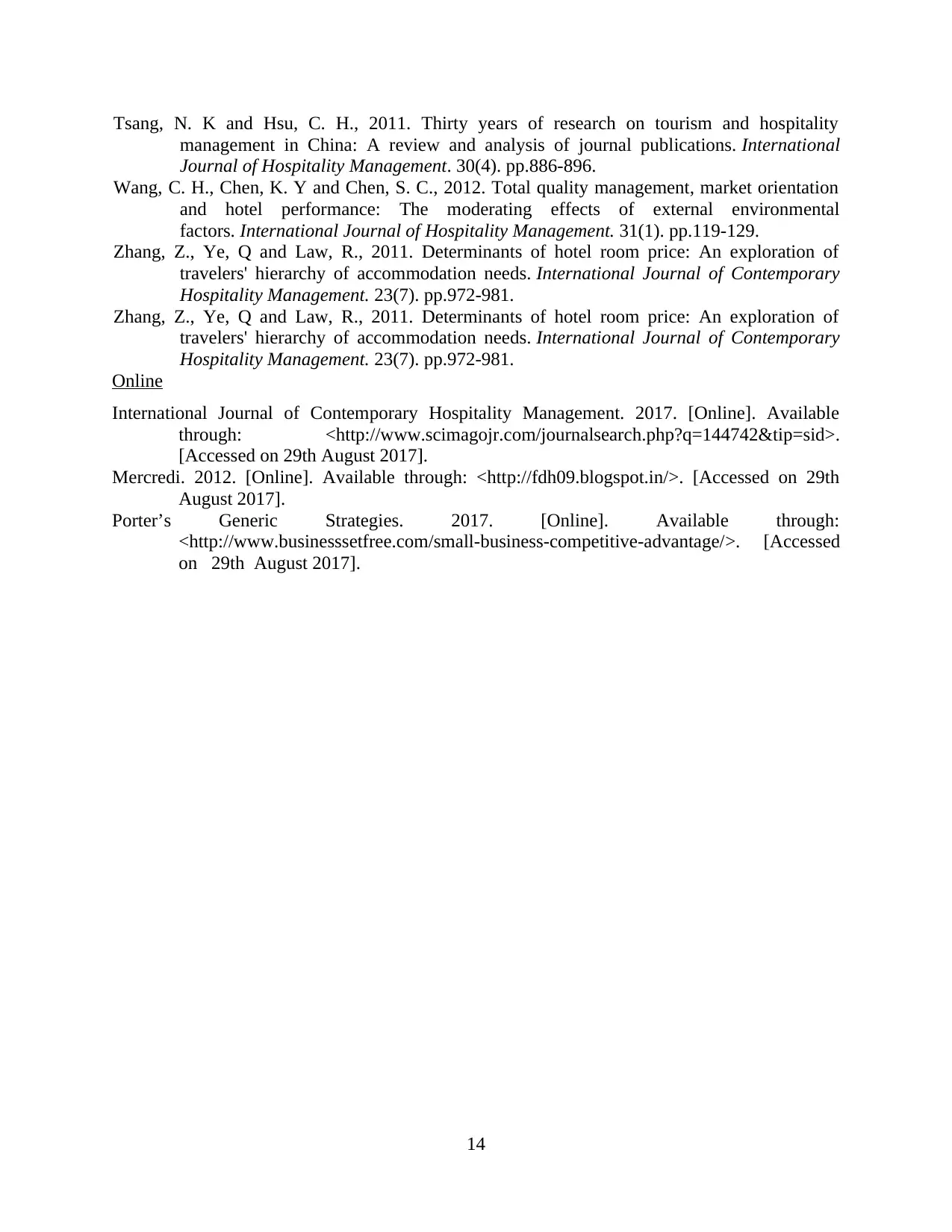
Tsang, N. K and Hsu, C. H., 2011. Thirty years of research on tourism and hospitality
management in China: A review and analysis of journal publications. International
Journal of Hospitality Management. 30(4). pp.886-896.
Wang, C. H., Chen, K. Y and Chen, S. C., 2012. Total quality management, market orientation
and hotel performance: The moderating effects of external environmental
factors. International Journal of Hospitality Management. 31(1). pp.119-129.
Zhang, Z., Ye, Q and Law, R., 2011. Determinants of hotel room price: An exploration of
travelers' hierarchy of accommodation needs. International Journal of Contemporary
Hospitality Management. 23(7). pp.972-981.
Zhang, Z., Ye, Q and Law, R., 2011. Determinants of hotel room price: An exploration of
travelers' hierarchy of accommodation needs. International Journal of Contemporary
Hospitality Management. 23(7). pp.972-981.
Online
International Journal of Contemporary Hospitality Management. 2017. [Online]. Available
through: <http://www.scimagojr.com/journalsearch.php?q=144742&tip=sid>.
[Accessed on 29th August 2017].
Mercredi. 2012. [Online]. Available through: <http://fdh09.blogspot.in/>. [Accessed on 29th
August 2017].
Porter’s Generic Strategies. 2017. [Online]. Available through:
<http://www.businesssetfree.com/small-business-competitive-advantage/>. [Accessed
on 29th August 2017].
14
management in China: A review and analysis of journal publications. International
Journal of Hospitality Management. 30(4). pp.886-896.
Wang, C. H., Chen, K. Y and Chen, S. C., 2012. Total quality management, market orientation
and hotel performance: The moderating effects of external environmental
factors. International Journal of Hospitality Management. 31(1). pp.119-129.
Zhang, Z., Ye, Q and Law, R., 2011. Determinants of hotel room price: An exploration of
travelers' hierarchy of accommodation needs. International Journal of Contemporary
Hospitality Management. 23(7). pp.972-981.
Zhang, Z., Ye, Q and Law, R., 2011. Determinants of hotel room price: An exploration of
travelers' hierarchy of accommodation needs. International Journal of Contemporary
Hospitality Management. 23(7). pp.972-981.
Online
International Journal of Contemporary Hospitality Management. 2017. [Online]. Available
through: <http://www.scimagojr.com/journalsearch.php?q=144742&tip=sid>.
[Accessed on 29th August 2017].
Mercredi. 2012. [Online]. Available through: <http://fdh09.blogspot.in/>. [Accessed on 29th
August 2017].
Porter’s Generic Strategies. 2017. [Online]. Available through:
<http://www.businesssetfree.com/small-business-competitive-advantage/>. [Accessed
on 29th August 2017].
14
1 out of 17
Related Documents
Your All-in-One AI-Powered Toolkit for Academic Success.
+13062052269
info@desklib.com
Available 24*7 on WhatsApp / Email
![[object Object]](/_next/static/media/star-bottom.7253800d.svg)
Unlock your academic potential
© 2024 | Zucol Services PVT LTD | All rights reserved.





